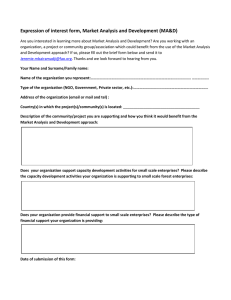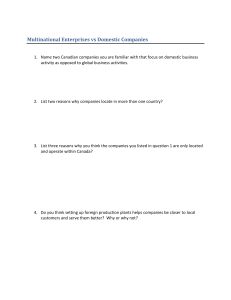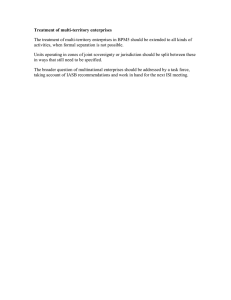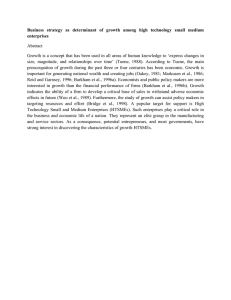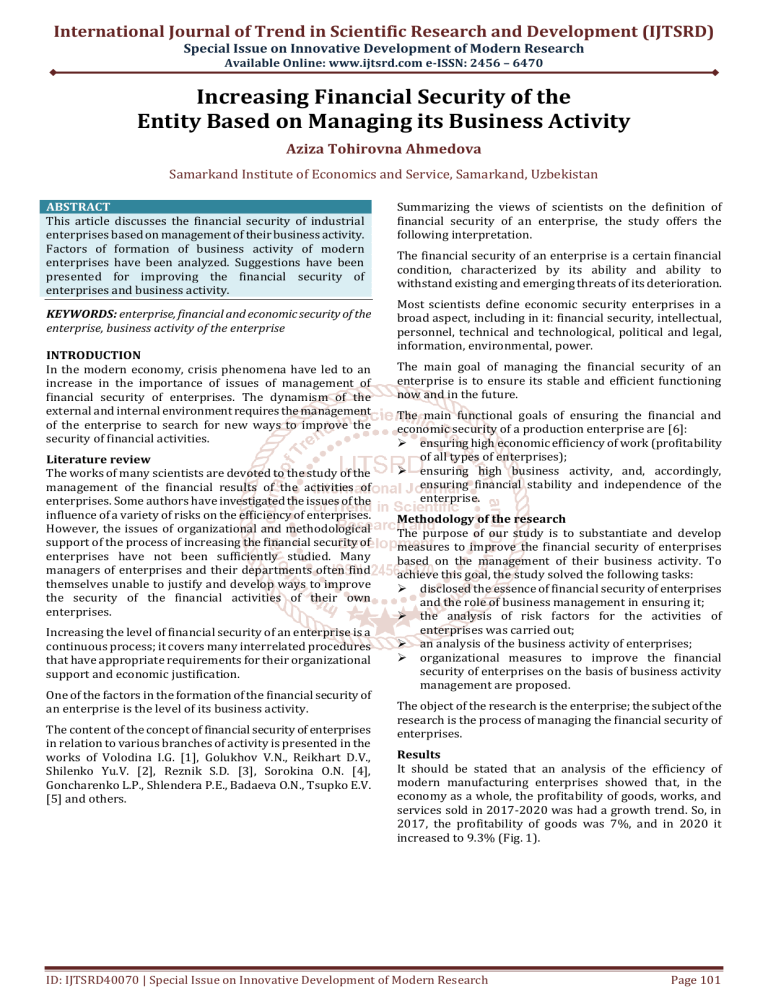
International Journal of Trend in Scientific Research and Development (IJTSRD)
Special Issue on Innovative Development of Modern Research
Available Online: www.ijtsrd.com e-ISSN: 2456 – 6470
Increasing Financial Security of the
Entity Based on Managing its Business Activity
Aziza Tohirovna Ahmedova
Samarkand Institute of Economics and Service, Samarkand, Uzbekistan
ABSTRACT
This article discusses the financial security of industrial
enterprises based on management of their business activity.
Factors of formation of business activity of modern
enterprises have been analyzed. Suggestions have been
presented for improving the financial security of
enterprises and business activity.
KEYWORDS: enterprise, financial and economic security of the
enterprise, business activity of the enterprise
INTRODUCTION
In the modern economy, crisis phenomena have led to an
increase in the importance of issues of management of
financial security of enterprises. The dynamism of the
external and internal environment requires the management
of the enterprise to search for new ways to improve the
security of financial activities.
Literature review
The works of many scientists are devoted to the study of the
management of the financial results of the activities of
enterprises. Some authors have investigated the issues of the
influence of a variety of risks on the efficiency of enterprises.
However, the issues of organizational and methodological
support of the process of increasing the financial security of
enterprises have not been sufficiently studied. Many
managers of enterprises and their departments often find
themselves unable to justify and develop ways to improve
the security of the financial activities of their own
enterprises.
Increasing the level of financial security of an enterprise is a
continuous process; it covers many interrelated procedures
that have appropriate requirements for their organizational
support and economic justification.
One of the factors in the formation of the financial security of
an enterprise is the level of its business activity.
The content of the concept of financial security of enterprises
in relation to various branches of activity is presented in the
works of Volodina I.G. [1], Golukhov V.N., Reikhart D.V.,
Shilenko Yu.V. [2], Reznik S.D. [3], Sorokina O.N. [4],
Goncharenko L.P., Shlendera P.E., Badaeva O.N., Tsupko E.V.
[5] and others.
Summarizing the views of scientists on the definition of
financial security of an enterprise, the study offers the
following interpretation.
The financial security of an enterprise is a certain financial
condition, characterized by its ability and ability to
withstand existing and emerging threats of its deterioration.
Most scientists define economic security enterprises in a
broad aspect, including in it: financial security, intellectual,
personnel, technical and technological, political and legal,
information, environmental, power.
The main goal of managing the financial security of an
enterprise is to ensure its stable and efficient functioning
now and in the future.
The main functional goals of ensuring the financial and
economic security of a production enterprise are [6]:
ensuring high economic efficiency of work (profitability
of all types of enterprises);
ensuring high business activity, and, accordingly,
ensuring financial stability and independence of the
enterprise.
Methodology of the research
The purpose of our study is to substantiate and develop
measures to improve the financial security of enterprises
based on the management of their business activity. To
achieve this goal, the study solved the following tasks:
disclosed the essence of financial security of enterprises
and the role of business management in ensuring it;
the analysis of risk factors for the activities of
enterprises was carried out;
an analysis of the business activity of enterprises;
organizational measures to improve the financial
security of enterprises on the basis of business activity
management are proposed.
The object of the research is the enterprise; the subject of the
research is the process of managing the financial security of
enterprises.
Results
It should be stated that an analysis of the efficiency of
modern manufacturing enterprises showed that, in the
economy as a whole, the profitability of goods, works, and
services sold in 2017-2020 was had a growth trend. So, in
2017, the profitability of goods was 7%, and in 2020 it
increased to 9.3% (Fig. 1).
ID: IJTSRD40070 | Special Issue on Innovative Development of Modern Research
Page 101
International Journal of Trend in Scientific Research and Development (IJTSRD) @ www.ijtsrd.com eISSN: 2456-6470
Fig. 1. Indicators of profitability of sold goods (labor, services) and profitability of assets of industrial enterprises
in 2017-2020, % [7]
Comparing the results of 2020 with a more prosperous period in economic terms, when the profitability of goods was at the
level of 13.5% (2018), we can note the presence of growth reserves for this indicator, as well as the availability of opportunities
to reduce costs associated with the production and sale of goods, works and services, and the growth of profit from sales.
The level of business activity of enterprises directly affects their financial and economic situation. Deterioration of business
activity of enterprises, or, in other words, a slowdown in the turnover of investments, also reduces the level of financial and
economic security. A similar slowdown in the turnover of funds invested in current assets of enterprises is evidenced by the
presence and growth of overdue receivables. The amount of overdue receivables in the economy as a whole in 2020 amounted
to 2.2 trillion rubles. This is 12% more than in 2019, and in 2019 the indicator increased by 28% from the level of 2018 (Table
1).
№
1
2
3
Table 1 Accounts payable and receivable of enterprises in 2017-2020 [7]
Indicators
2017
2018
2019
2020
Total liabilities of enterprises, mln.soums 12178969 58340477 75182475 89014617
Creditor liabilities, mln.soums
6389304 27531558 33173617 38925596
including overdue
956356
1469645
1881316
2428757
Receivable liabilities, mln.soums
6331251 26263685 31013596 35736421
including overdue
855998
1482765
2015920
2275556
The main indicators of the business activity of industrial
manufacturing enterprises annually assessed by state
statistics are:
general demand for products (order book);
release of the main product in kind;
stocks of finished products.
The analysis of these indicators showed that, according to
two of the three indicators, the business activity of industrial
production enterprises declined in 2019-2020.Thus, the
demand for products, according to the estimates of
enterprise managers, decreased only in 2020 by 41.75% on
average per year. The output of the main product in 2020
increased by14.5% and stocks of ready goods decreased by
4.5%.
The following are noted as the main factors limiting the
business activity of organizations [7, p. 217]:
insufficient demand in the domestic market (in 2020,
55% surveyed organizations);
a high level of taxation (in 2020, it was noted in 40%
surveyed organizations);
–A high percentage of commercial loans (in 2020, it was
noted in 30% surveyed organizations);
lack of financial resources (in 2020, it was noted in 40%
of the surveyed organizations);
lack of skilled workers (in 2020, it was noted in 22%
surveyed organizations);
deterioration and lack of equipment (in 2020, it was
noted in 22% surveyed organizations).
The study developed a model for managing the business
activity of a manufacturing enterprise, which will allow,
through the performance of management functions for each
separate type of activity, to obtain the necessary information
not only about the state of business activity, but also about
the results of its management. In addition, the model
assumes the formation of tools and a concept of business
management at the same time, the basis for improving the
financial and economic security of a production enterprise is
the management of its business activity.
The directions of ensuring and maintaining the business
activity of a manufacturing enterprise are proposed,
including: increasing the volume of sales of profitable
products in accordance with market demand;
implementation of the economy regime at the enterprise in
the direction of reducing all types of costs; improvement of
the price mechanism, taking into account the improvement
of the quality and competitiveness of products; pursuing a
policy of reinvesting net profit in production, thus
minimizing the use of long-term borrowed resources;
maximization of the autonomy ratio, that is, the share of
equity capital in the balance sheet; use, if necessary, of
borrowed capital to maintain and develop economic growth,
without violating, at the same time, the financial stability of
the enterprise; ensuring the acceleration of asset turnover by
optimizing the ratio of non-current and current assets (with
an increase in the share of the latter), which will reduce the
relative need for them.
ID: IJTSRD40070 | Special Issue on Innovative Development of Modern Research
Page 102
International Journal of Trend in Scientific Research and Development (IJTSRD) @ www.ijtsrd.com eISSN: 2456-6470
Conclusion
Summing up, it can be said that the financial security of an
enterprise is a certain financial condition, characterized by
its ability and ability to withstand existing and emerging
threats of its deterioration. Additionally, increasing the level
of financial security of an enterprise is a continuous process;
it covers many interrelated procedures that have
appropriate requirements for their organizational support
and economic justification.
[3]
Reznik S.D. Higher economic security management
educational institution. Textbook. - M .: Publishing
house: "Infra-M", 2015. - 352 p.
[4]
Sorokina ON The content of the financial security of
the enterprise // Russian entrepreneurship. - 2012. No. 14 (212). - with. 74-80.
[5]
Badaeva O. N., Tsupko E. V. Assessment of the
financial security of small and medium-sized
enterprises // Russian Entrepreneurship. - 2013. - No.
14 (236). - with. 71-83.
[6]
Dzhevitskaya E.S. Business performance management
technologies activities of a production organization /
Management: experience, problems, prospects.
Monograph. - Penza: PGUAS, 2016. - P. 21.
[7]
Statistical collection in numbers. 2017: Brief stats. /
2017 - 543 p.
[8]
Zaynalov D. R., Ahrorov Z. O. Influence of Taxes in the
Mobilization of Financial Resources //International
Journal of Current Engineering and Technology. –
2019. – Т. 9. – №. 3. – С. 448.
One of the factors in the formation of the financial security of
an enterprise is the level of its business activity.
References
[1] Volodina I. G. Ways to ensure financial security
enterprises // Young scientist. - 2013. - No. 9. - S. 156160.
[2]
Golukhov G.N., Reikhart D.V., Shilenko Yu.V. Financial
and economic safety of medical-industrial complex
organizations // Health Economics, No. 4, 1999. - P.
19-20.
ID: IJTSRD40070 | Special Issue on Innovative Development of Modern Research
Page 103

